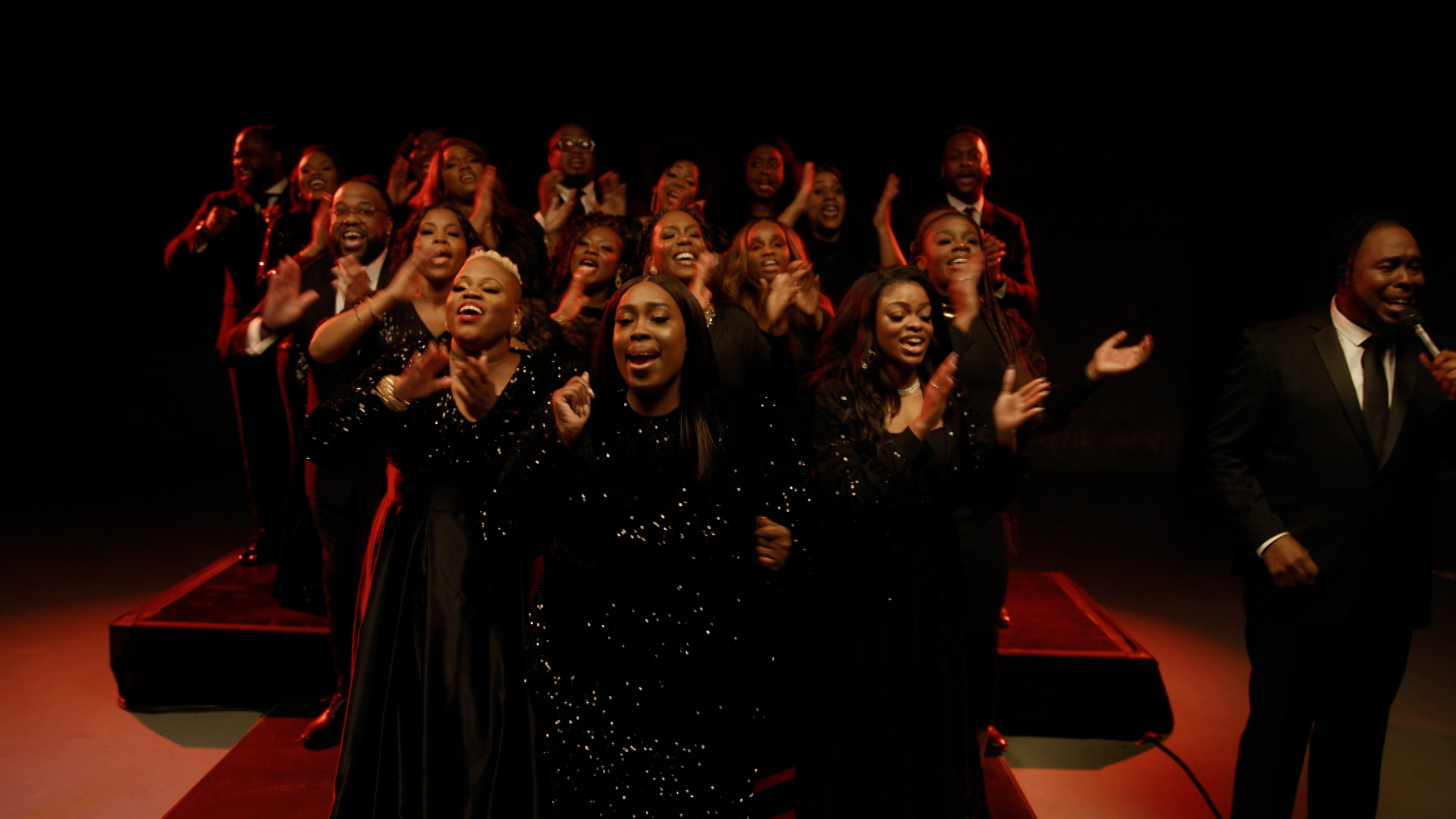The article below, written for BlackPast.org by Harvard Professor Henry Louis Gates Jr., describes the role of gospel music in influencing almost all other African American musical genres and in turn impacting all American music. Professor Gates has published numerous books and produced and hosted an array of documentary films. His latest history series for PBS, GOSPEL, premiered in February 2024.
From jazz to the blues to hip-hop, African Americans have been a driving force of sonic innovation for over a century. While musical styles come and go, there is one sound that has been a constant source of strength, courage, and wisdom. It delivers a message that resounds from the pulpit to the choir lofts on any given Sunday—one of good news in bad times: gospel. But gospel is more than the soundtrack of the African American experience. It’s the heart and soul.
The early to mid-20th century in the United States witnessed a transformative period characterized by significant population shifts, cultural explosions, and the pursuit of civil rights. The convergence of the Great Migration, gospel music, and the civil rights movement produced an intricate tapestry of social change that endures today. Black gospel music and preaching is one of constant movement, threading African American culture together and encapsulating the essence of faith, resilience, and community.
In the first half of the twentieth century, the Great Migration (1910-1970) marked a colossal demographic shift within the United States. This exodus of African Americans from rural communities in the South to bustling cities in the North promised newfound opportunities and freedoms. Driven by the promise of greater economic prospects, escape from the harsh realities of Jim Crow segregation, and the hope of political enfranchisement, millions of African Americans embarked on this arduous journey.
The church played a crucial role during this time. The sermons and music provided comfort and fostered resilience and unity within African American communities throughout their journey. Gospel music, deeply intertwined with the church, evolved alongside the Great Migration.
The 1920s and 1930s marked a pivotal era in gospel music, as the rhythms of the urban landscape merged with spiritual fervor. Chicago was a burgeoning metropolis and melting pot of cultures. Thousands of African Americans arrived in Chicago to start new lives, including Black gospel pioneers Thomas A. Dorsey from Georgia in 1916 and Mahalia Jackson from New Orleans in 1927. The city’s vibrant music scene, influenced by a multitude of traditions, provided fertile ground for the development of new musical genres, including jazz and blues, that enabled gospel to grow into a powerful tool of expression. Characterized by its improvisational nature and complex rhythms, jazz left an indelible mark on gospel music.
Emerging recording technologies played a significant role throughout the history of gospel music. In 1926, Rev. J. M. Gates recorded a staggering ninety sermons in New York City. Columbia Records released the sermons, making Gates a superstar. That same year, Arizona Dranes, a blind woman, created sacred recordings in a Chicago studio. In 1927, the Baptist minister Rev. A. W. Nix and the Pentecostal minister Rev. Leora Ross, both of Chicago, released records to great acclaim. Gospel artists and preachers took to the radio as well. Georgia-born Elder Lucy Smith broadcast her Chicago services on the program The Glorious Church of the Air as far as Mexico.
Houses of worship like the First Church of Deliverance, founded in Chicago in 1929 by the charismatic preacher Clarence H. Cobbs, created a unique fusion bridging jazz and gospel traditions. The church had a transformative impact on the style and the business of gospel music. In the late 1930s, composer and choir director Kenneth Morris introduced the Hammond organ at Rev. Cobbs’ church. Soon the Hammond became an integral part of the worship service, paving the way for churches to refine choral arrangements, harmonies, and call-and-response techniques, thus creating a distinctive sound that brought a new level of musical sophistication that set gospel apart. In 1939, Morris, along with the singer Sallie Martin, a fellow congregant, established a publishing powerhouse that spread the word through the printing of gospel sheet music.

Blues also played a crucial role in shaping the genre. Its raw expressions of hardship and hope resonated in gospel, infusing it with passionate vocals and themes of redemption. Many early gospel musicians, such as Dorsey, who is credited as the “Father of Gospel Music,” and Sister Rosetta Tharpe, were deeply influenced by the blues, inspiring their sacred music with soulful expression.
As more African Americans moved north throughout the 1940s and ’50s, the city of Detroit put its own stamp on the gospel sound with the emergence of influential figures like Rev. C. L. Franklin, who had moved to the Motor City from Mississippi in 1946. Franklin’s impassioned sermons and innovative preaching style, known as “whooping,” marked the genre with its use of repetition, call-and-response patterns, and the incorporation of musical elements. This fusion of preaching and musicality created an emotional resonance that reverberated deeply with congregants. His ability to communicate complex theological concepts in an accessible and emotionally stirring manner earned him a devoted following and solidified his reputation as one of the foremost preachers of his time. Franklin greatly influenced his daughter, Aretha Franklin, who sang in his church as a young girl and would eventually also make her mark on gospel.
The vibrant gospel scenes of Chicago and Detroit in the mid-twentieth century became a destination for musical innovation, forging legends such as Franklin, composer James Cleveland, and Mahalia Jackson, whose 1947 hit “Move On Up a Little Higher” launched gospel’s golden age. Their contributions revolutionized gospel music and played a significant role in the broader context of American culture, intersecting with the civil rights movement, then led by a young, charismatic Baptist minister from Georgia named Martin Luther King, Jr.
Mahalia Jackson’s music often provided inspiration to Dr. King, who recognized gospel’s power as a unifying force. Jackson stood behind King during his seminal “I Have a Dream” speech at the March on Washington on August 28, 1963. At this critical moment, as King addressed the crowd at the Lincoln Memorial, Jackson’s urging led him to speak spontaneously about his dream for racial equality. Her impromptu intervention forever linked her powerful voice to King’s iconic vision.
Similarly, James Cleveland’s music provided a spiritual soundtrack to the civil rights movement, offering solace and inspiration to those engaged in the struggle for equality. While Dr. King used his oratorical skills and leadership to galvanize a movement, Cleveland used his musical genius, his soul-stirring gospel music resonating in the hearts of many and earning him the status “King of Gospel.”
Following Dr. King’s assassination in 1968 and into the early 1970s, the civil rights movement underwent a transition, embracing a broader spectrum of issues, including women’s rights, environmental concerns, and opposition to the Vietnam War. Black pastors such as Rev. Gardner C. Taylor emerged as influential voices, using their pulpit as a platform for addressing issues of civil rights, social justice, and equality. This era saw the emergence of a vibrant counterculture advocating for peace, love, and social change. Musically, gospel influences were mixed into various genres, giving birth to soul, funk, and disco, whose songs became the anthems of empowerment and unity that transcended the boundaries of religious expression.

During this time, gospel music was also evolving on the West Coast, and gospel family dynasties, especially those from the Church of God in Christ (COGIC), dominated the charts for the next few decades, with the Hawkins Family at the vanguard. Their 1969 hit “Oh Happy Day” marked the beginning of an era where gospel was drawing secular audiences and topping secular charts.
Events like the Watts Summer Festival in California in 1972 would see gospel artists like The Rance Allen Group and the Staple Singers share the stage with soul, funk, and R&B performers. Artists like Marvin Gaye, Andraé Crouch, and Aretha Franklin would expand their musical reach and use their lessons from the church to create a distinctive sound.
Throughout the ’70s, gospel artists continued to push the boundaries of disco music by experimenting and sampling R&B hits. The Clark Sisters took a message steeped in COGIC to the dance floor with their hit song “You Brought the Sunshine,” and COGIC royalty Crouch crossed barriers of race with his take on gospel music, becoming an international singing star and a hit-making producer for Michael Jackson, Madonna, and other pop icons of the day.
By the early 1990s, a new generation of songwriters, record executives, performers, and preachers came of age to catapult Black preaching and gospel to extraordinary levels of commercial success. The decade saw the genre evolve beyond its traditional roots, blending contemporary sounds with timeless spiritual messages. As the industry expanded, new figures played key roles in redefining gospel’s landscape. Foremost among these luminaries were Vicki Mack Lataillade, who co-founded the influential independent gospel label GospoCentric; Kirk Franklin, who launched the platinum age of gospel with the crossover 1997 smash “Stomp,” an irresistible combination of gospel and R&B, hip-hop, and pop elements; Yolanda Adams, who was instrumental in bridging the gap between traditional and contemporary gospel styles, earning the title “First Lady of Modern Gospel”; and Bishop Hezekiah Walker and John P. Kee, who led churches that became massive gospel venues.
Yet amid the successes of the ’90s, the gospel community faced heart-wrenching losses due to the AIDS crisis. Choir members, church leaders, and performers were among those affected, leaving a profound impact on the community. Gospel music, with its transcendent melodies and uplifting lyrics, provided a soundtrack to this struggle. Songs of faith, resilience, and hope resonated deeply with those facing the harsh realities of the epidemic.
The legacy of the AIDS crisis still echoes through gospel music and preaching. While medical advances transformed the landscape of HIV/AIDS, the compassion and inclusivity fostered during that time prevail as central tenets of gospel communities. In the 21st century, gospel music remains a source of endurance, especially in the face of the COVID-19 pandemic. Virtual choirs and online services have allowed believers to stay connected and find solace in their faith. Gospel’s ability to transcend boundaries and provide spiritual nourishment has been crucial in navigating these unprecedented challenges.
Today, gospel music continues to thrive. The Great Migration, civil rights movement, and modern challenges and triumphs coalesced with the evolution of gospel to form pivotal chapters in the saga of African American resilience, creativity, and determination. Throughout these moments in history, gospel music and preaching have exemplified the enduring strength of community and the human spirit, providing a source of hope and fortitude that resonates across generations and reminds us of the power of music and faith in times of struggle.

